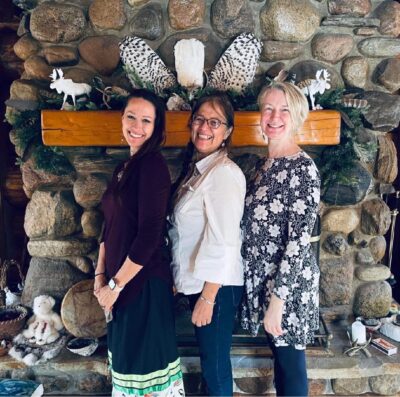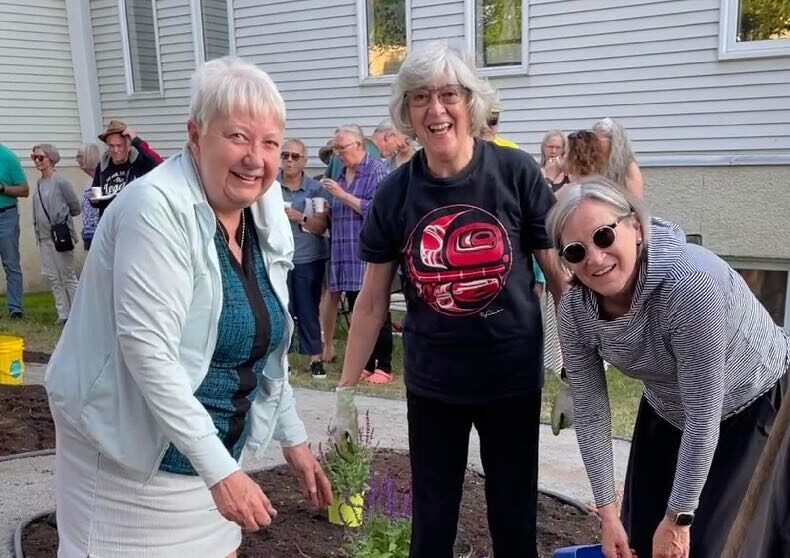At St. James, Manotick, 2023 was a year of planting, growing and learning in an effort to deepen and live out the Church’s commitment to healing and reconciliation with Indigenous peoples.
Through the parish Indigenous Relations Circle (IRC), with a grant from the Diocesan Healing and Reconciliation Fund, they contributed to healing, reconciliation and understanding through the following activities:
- Designed and implemented a healing garden on the lands adjacent to the church
- Provided support for a local healing forest at Misiwe Ni Relations Healing Lodge
- Listened to and learned from Elders and Knowledge Keepers about cultural and tradition
- Connected with local Indigenous communities and cultures
- Learned the history and truths through educational events
- Integrated Indigenous process/worldview and advancing reconciliation as a spiritual practice
“We were inspired to create the healing garden at St. James after seeing the Healing Garden at the Misiwe Ni Relations Healing Lodge near Manotick in the spring of 2022,” parishioners John Herity and Terry Tomkins recall.
Support and advice from Elder Denise Anne Boissoneau, Jenny Šâwanohk, local Indigenous community partner and owner of Misiwe Ni Relations Healing Lodge, and Knowledge Keeper William Mameanskum were integral to IRC discussions as they designed and created the healing garden. The garden will be named Minaadendamowin, an Ojibway word meaning respect, which is also one of the Seven Grandfather Teachings.
“We hoped to create something at the church to advance reconciliation as a spiritual practice and show respect for Indigenous partners,” the Indigenous Relations Circle explained. “We connected the land, relationships, the people of our parish, and the community. The garden became a reality through a consensus-based process and engagement with Indigenous partners. The response from the parish and Indigenous partners was overwhelmingly positive.”
In 2024, St. James hopes to install signage and education panels describing the garden’s main features and planting that represent Indigenous ways, beliefs and practices. The garden is 28 feet in diameter, reflective of the lunar cycle and symbolic of the Turtle shell. The four main beds reflect the Indigenous medicine wheel and are oriented in the four directions: East (yellow, with ceremonial tobacco); South (red, with cedar); West (black, with Canadian purple sage); and North (white, with sweetgrass). These colours were used in painted river rock borders. The central focal point is a large boulder from the church property, which can also be a support for ceremony. There are four benches where visitors can enjoy quiet contemplation and participate in education discussions, both planned and spontaneous. There is also a large amethyst stone, near the entrance, protecting the garden and welcoming visitors, directing them to the centre along mobility-friendly pathways.
Shirley Hilchuk, one of the parishioners who has volunteered to water the garden, said, “The garden is one step towards reconciliation by educating others and showing respect for Indigenous beliefs and values.”
2024 will be the first year for Minaadendamowin Garden to be a place for sharing and learning throughout the growing season. St. James’ IRC is working to have the healing garden recognized as part of the National Healing Forest Initiative, started in 2015, (nationalhealingforests.ca). All are welcome to visit the garden at any time.
In addition to the garden installation, our community advanced our understanding of the history and truths of colonialism and its impact through a Kairos Blanket Exercise. The learning event was held on Oct.1 in honour of the National Day of Truth and Reconciliation. About 30 participants from St. James, Manotick United Church, and Misiwe Ni Relations Healing Lodge were joined by Indigenous facilitators, John Henri and Julien Commanda, whose personal insights enriched the experiential learning experience.
It is with deep gratitude and respect that we say miigwetch to Indigenous partners and thank you to the Diocesan Healing and Reconciliation Fund for making this possible!
—Indigenous Relations Circle and Convener, Sharla Sandrock

Photo: contributed
Thoughts from Indigenous Knowledge Keepers
I see hope for reconciliation in these projects. The design for this garden came from the one that I created on my home property over 10 years ago. It was quite a bit larger, and I could not care for it on my own. I have since moved and it has weighed heavy on my heart.
I have realized that these endeavours and sacred spaces require a community of love, care and support. We are in the time of mending the Sacred Hoop, and it requires everybody’s efforts. Having a garden created for All to visit, and one that is rooted in our Indigenous Spirituality (which is very similar to the foundations of Christianity) is reconciliation at its best. We were removed from our Land, and this is a symbol of how we are not only welcomed back onto it, but in the principles of that which caused our removal in this first place: our Sacred and Spiritual ties to the Land. It is so healing. It’s also very important that our Indigenous voices are not only heard, but are leading the projects. It takes a simple land acknowledgement beyond a courtesy, to the actioning of what an acknowledgement actually means. -— Jenny Šâwanohk
The participation within was created by the Indigenous Circle among our homes, online and in community. We earned mutual trust, interconnecting our first step on the land. The eagle feather’s guidance symbolized spiritual practices within our church. Minaadendamowin Garden widened the learning and growth that arose from the wisdom of the land, healing and our encounters. We gathered, listening to elements of human nature relating the rocks, water, fire, and air as sacred breath. Faith, through spiritual leadership, cultured wholeness of one heart and mind.
—Denise Anne Boissoneau







“Grow old along with me! The best is yet to be.”